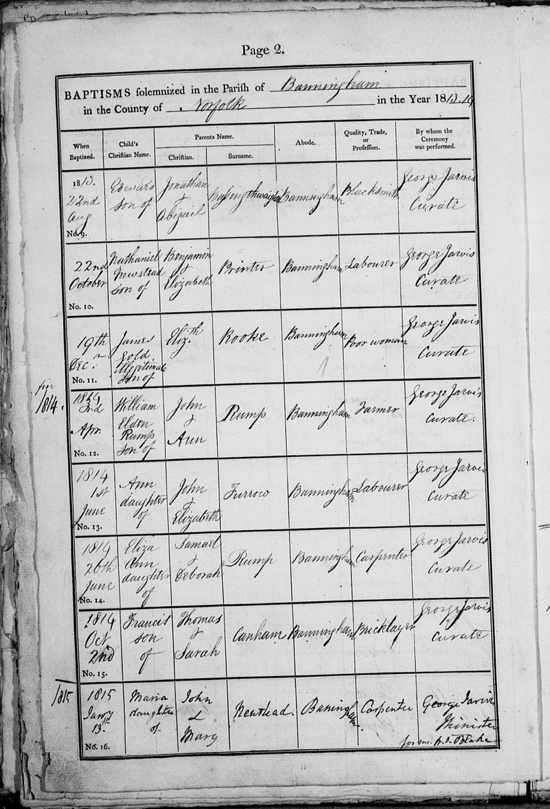You
are receiving this because your address is subscribed at: www.jaunay.com/newsletter.html |
|
 |
| No: 118 |
December 2015
|
|
News December Seminars 6: Port Adelaide Heritage Walk: Government precinct 2:00–4:00pm WEA Centre Adelaide January Seminars No seminars in January All bookings must be made with the hosting organisation. See the seminar program for more details and bookings. Finding birth records If you are having trouble find a birth certificate in the index then read on… When searching indexes ignore all but the first given name and surname. In fact if using a database search engine avoid searching on any given name unless the family name is extremely common! The forename you think was your ancestor’s may differ. People were known to change an unliked given name. Remember that some people were actually called Tom, Dick or Harry. You may know the person by a middle name because the first name was common in the family. The fashion for more than one given name only became overwhelmingly popular in the latter part of the 19th century. At the beginning of the century several given names were quite rare. Your ancestor may have adopted another given name later in life. |
In
this issue: |
|
Graham Jaunay Services
|
| If you cannot find the person under their expected surname then check using the motherís family name. It is possible the parents were not married at the time of birth and then the records should be, but not always, under the motherís name. Whatever the case the name recorded will be the name disclosed. The clerk involved did not undertake any formal checks! If the parents were living together, the mother may have already adopted her partnerís name for respectability. Often when fathers died and mothers remarried, the children took their step-fatherís name. Often in the pursuit of ancestry we rely on the marriage certificate to determine the names of the coupleís fathers. This could prove to be a problem if one of the couple did not know their father as a consequence of a marriage breakup or death when the child was very young. Often your ancestors felt obliged to tell the celebrant something and made guesses or just simply told an untruth. After all not many would have wanted to admit being illegitimate or may have never been given the truth by their mothers. When it comes to more common names often the searcher is reliant on the birthplace of their ancestor. Many did not know where they were born and wrongly assume the place they lived when young was the birthplace and thus records completed by the person themselves may be incorrect and thus differ from that on the birth or baptism certificate. Records completed by parents are more likely to be correct. In some jurisdictions the place recorded on the birth certificate may not be the place of birth but the place of residence! In South Australia both were acceptable for the purposes of the birth certificate and neither were sought until the very end of the 19th century. If you are using censuses to locate birth records, then not only does the place of birth become questionable but ages are often wrong or massaged to retain respectability. We see the same in marriage certificates when ages are adjusted up to 21 plus to avoid the need to secure parental permission or made to converge when there is a considerable gap between the ages of the couple. Certificates recording the ages as, full age need to be treated with suspicion. Often these are the very people who were not of full age! Some people just were not aware of their correct age. Using a death certificate can cause problems as much of the data is often little more than a guess, especially when the deceased had no relatives. Even birth certificates are often wrong when it comes to the birth date. Births not registered within the statutory time attracted a penalty. This could be avoided by adjusting the date of birth. Sometimes births were not registered. You need to check when civil registration started and even that may not be an accurate guide. In South Australia civil registration started in mid-1842 but only covered two areas within the colony. Some parts of the colony had to wait more than ten years before their region was proclaimed a district. In the meantime parents were expected but not required to travel to the nearest district. This could be several hundreds of miles away and so never happened! In fact in the first almost 40 years of civil registration in England and Wales there was no compulsion to register. The onus was on the registrars and so many births were not registered. Many Catholics took advantage of this oversight as the birth of a child was considered by many to be none of the stateís business and confined their notification to the Church in the form of a baptism. Using military records to determine an approximate year of birth is fraught with issues and these ages were particularly rubbery! Turning to pre-civil registration we may just have to accept we will never know the date of birth and may have to be satisfied with at best a baptism date. While most baptisms happened shortly after birth this is not the case with all Christian denominations. Ironically the parish priests and clerks who were including birth dates in baptism registers were discouraged from doing so with the introduction of ruled registers in England and Wales in 1813. Provision to provide the birth date was omitted as depicted in the following register for Banningham NFK.  |
|
| To
unsubscribe send a blank email via the following link using the same
address you subscribed to: newsletter-leave@jaunay.com |